5G Transport Network
A 5G transport network connects a 5G RAN and core network.
To provide the ultra-high bandwidth, ultra-low latency, and flexible and intelligent connection services necessary in 5G application scenarios, the 5G transport network uses a new network architecture and key technologies.
What Are 5G's Requirements for Transport Networks?
Data services emerged in the 2G era, grew in the 3G era, and diversified in the 4G era. 5G is set to usher in an exciting new era, bringing superior experience and higher capacity, enabling the large-scale adoption of IoT, and penetrating into various industries.
At an ITU conference in 2015, major global carriers and equipment vendors jointly defined three typical application scenarios of 5G:
- Enhanced Mobile Broadband (eMBB): It is oriented to enhanced mobile Internet application scenarios and pursues ultimate communication experience between people. Typical applications include HD video, virtual reality (VR), cloud access, high-speed mobile Internet access, and artificial intelligence (AI).
- Massive Machine-Type Communications (mMTC): It is oriented to IoT device interconnection scenarios and meets communication requirements between people and things. Typical applications include environment monitoring, smart meter reading, and smart agriculture.
- Ultra-reliable low-latency communication (URLLC): It is oriented to special application scenarios in vertical industries and meets communication requirements between things. Typical applications include Internet of Vehicles (IoV), industrial control, smart manufacturing, and remote surgery.
5G will enable both human-centered communication and machine-type communication. Various service applications with differentiated features will coexist, posing significant challenges to 5G networks.
A 5G network consists of a RAN, transport network, and core network.
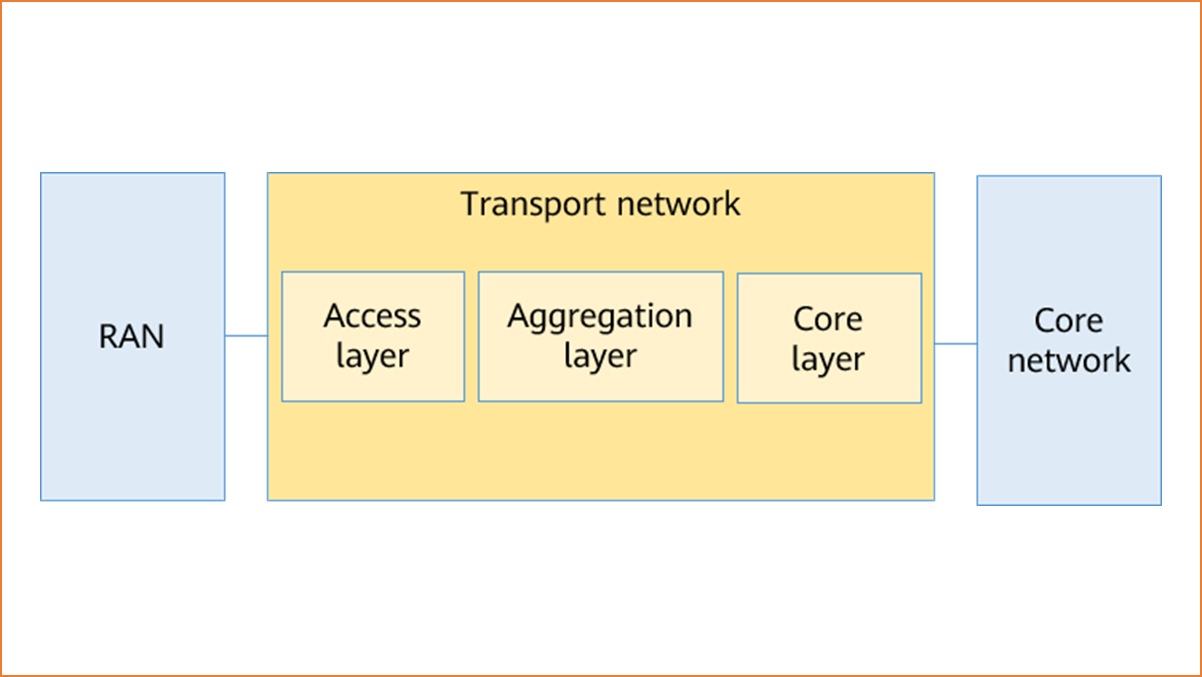
5G RAN, transport network, and core network
The 5G transport network (including the access, aggregation, and core layers) provides connection services for the 5G network. In the 5G era, the 5G transport network must meet the following requirements:
- Ultra-high bandwidth: In eMBB scenarios, 5G must support a peak rate of at least 10 to 20 Gbit/s (10 to 20 times higher than that of 4G) and a traffic density of at least 10 Mbit/s per square meter. In mMTC scenarios, 5G must support a connection density of at least 1 million connections per square kilometer. According to estimates, links on the 5G transport network are planned as follows: 10 Gbit/s link to a base station and 50 Gbit/s link per ring at the access layer; 100/400 Gbit/s link at the aggregation layer; and 400 Gbit/s link at the core layer.
- Ultra-low latency: In eMBB scenarios, latency on the user plane and control plane must be less than 4 ms and 10 ms, respectively. In URLLC scenarios, latency on the user plane and control plane must be less than 0.5 ms and 10 ms, respectively. This means that the E2E latency of the 5G transport network must be controlled within 2 ms to 4 ms. URLLC services that have strict requirements on the latency need to be implemented by adjusting the network structure. For example, a centralized unit (CU) and a distributed unit (DU) in the RAN are co-located, and the user plane of the core network is moved downward to the RAN.
- Flexible and intelligent: The transport network serves the three types of 5G scenarios. It must therefore provide the network slicing function so that different scenarios or services have their own independent logical networks. In addition, network evolution cannot be achieved overnight. The 5G transport network also needs to support multiple comprehensive services, such as 4G, 5G, and private line services, and software defined networking (SDN) needs to be introduced to implement E2E flexible management & control and intelligent O&M.
5G also poses new requirements on aspects such as the clock synchronization precision, reliability, and security of the transport network. These requirements need to be considered during planning and deployment of the 5G transport network.
What Is the Structure of a 5G Transport Network?
The following figure shows the target structure of a 5G transport network.

Target structure of a 5G transport network
Layer |
Main Content |
Main Characteristics |
|---|---|---|
Service transport layer |
Management plane: O&M and management |
Network controller, digital twin, and simplified O&M:
|
Control plane: control protocols |
Simplified protocols:
|
|
Forwarding plane: packet forwarding |
Efficient forwarding:
|
|
Logical topology layer |
Devices and logical connections |
Simplified architecture, ultra-high bandwidth, secure connections, and elastic scaling:
|
Infrastructure layer |
Equipment rooms and optical cables |
Optimal TCO and reliable infrastructure assurance:
|
Simplified Architecture
Network layer optimization: An LTE transport network has eight layers, whereas the 5G target network reserves a total of five layers, simplifying the network architecture.

Simplified target network architecture
- ACC: access router
- mEG: metro edge gateway
- mAEG: metro aggregation edge gateway
- mBB: metro backbone router
- 5G BB: backbone router
L3 to edge: The bandwidth of the access ring is 100 Gbit/s, and that of the aggregation and core layers is N x 100 Gbit/s.
Simplified Protocols
Network protocols are simplified. Specifically, the number of protocols is reduced from six to two, significantly lowering network O&M workloads.
EVPN carries Layer 2 and Layer 3 services in a unified manner, implementing flexible service deployment.

Simplified network protocols
Simplified O&M
The SDN strategy is deployed to implement functions such as automatic service provisioning, automatic O&M, proactive SLA awareness, and accurate fault locating.
The network controller (iMaster NCE) is introduced to provide intelligent and efficient network and service management experience.
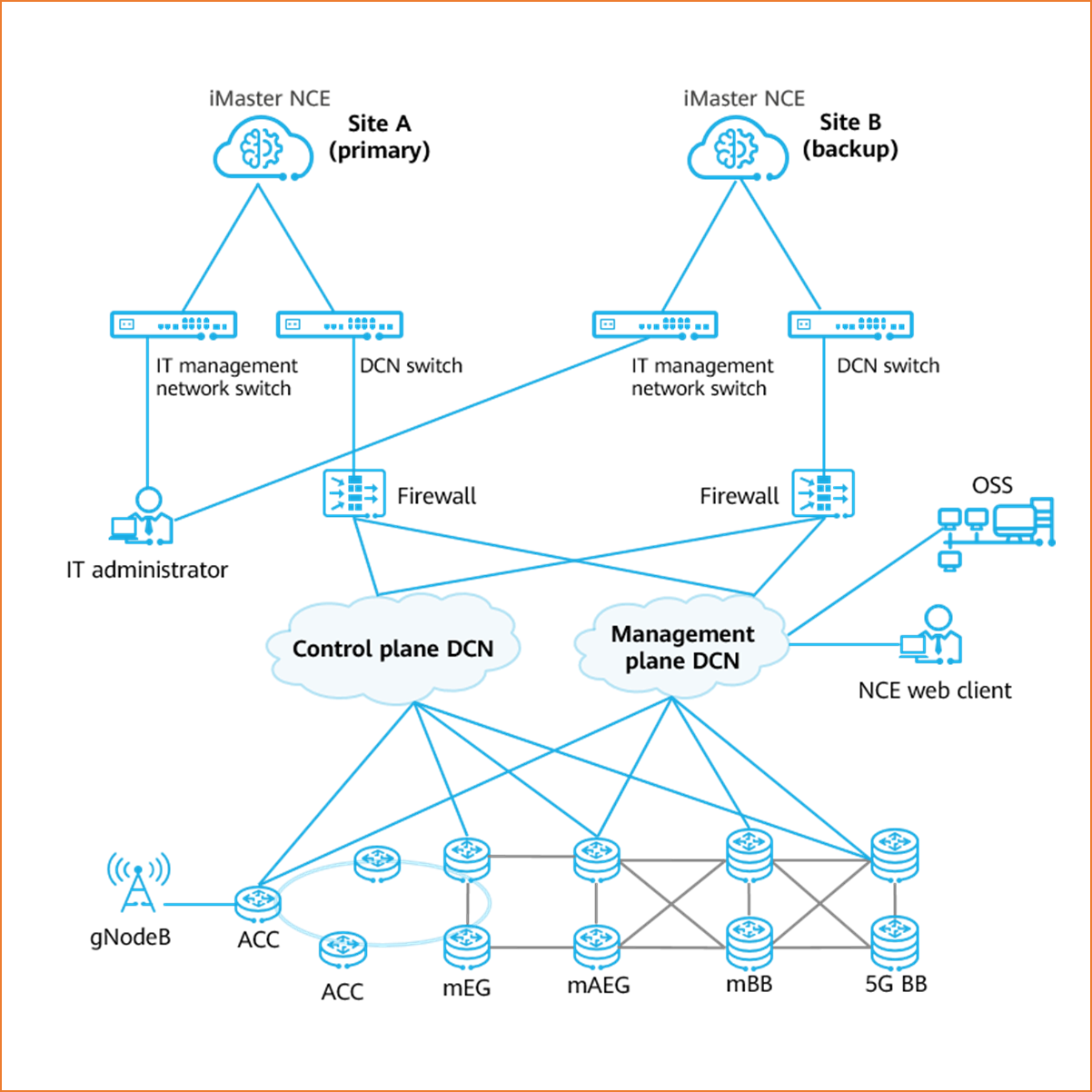
Using NCE to simplify network O&M
What Are the Key Technologies of a 5G Transport Network?
The 5G transport network will be integrated, simplified, intelligent, open, and flexible. Centering on distributed DCs, it will employ SDN to enable automation and intelligence, and leverage slicing to provide differentiated services. The following table lists the key technologies of a 5G transport network.
Category |
Key Technology |
|---|---|
Physical technologies |
WDM and PAM4 |
Tunneling technologies |
|
Routing technologies |
OSPF, IS-IS, and BGP |
VPN technologies |
L2VPN, L3VPN, and EVPN |
Synchronization technologies |
Synchronous Ethernet, IEEE 1588v2, ITU-T G.8275.1, and Atom GPS |
SDN technologies |
|
Slicing technologies |
OTN ODUk, HQoS, channelized sub-interface, and FlexE |
Reliability technologies |
IFIT, MPLS TE FRR, IP/VPN FRR, and TL-LFA FRR |
The following briefly describes some of the key technologies.
PAM4
PAM4 is four-level pulse amplitude modulation, whereas PAM2 is two-level pulse amplitude modulation, which is usually referred to as non-return-to-zero (NRZ).
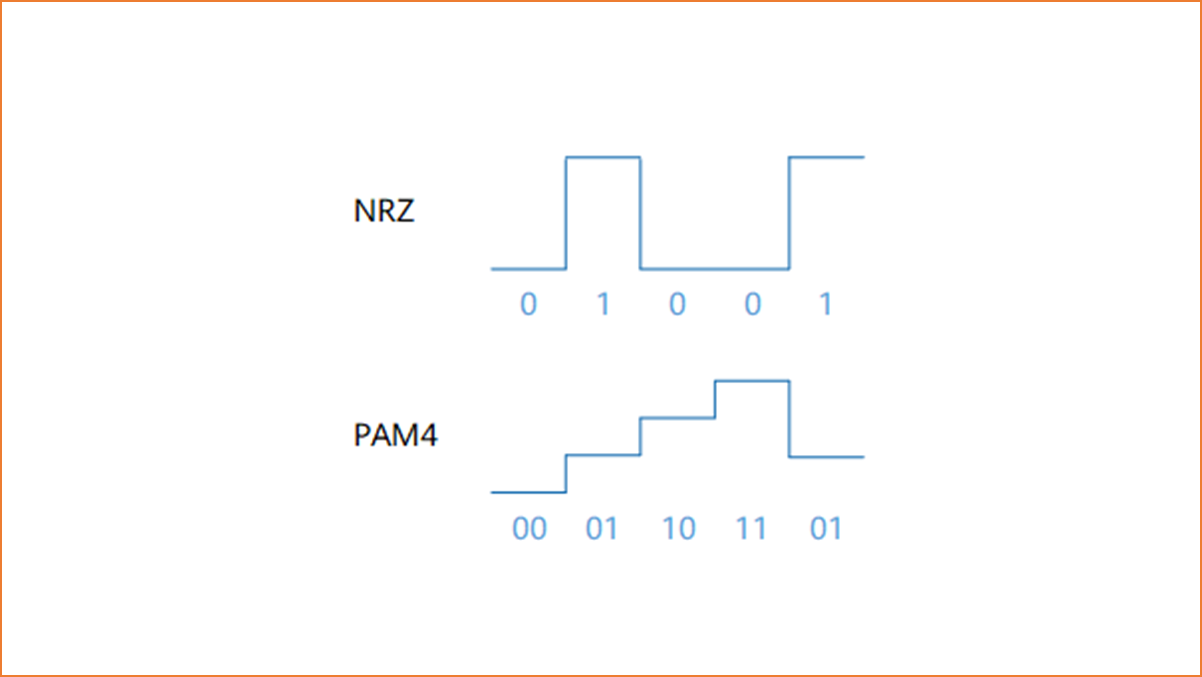
NRZ and PAM4
NRZ: uses two level codes. The high level is 1, and the low level is 0. Each level can represent one bit.
PAM4: uses four level codes, which are 00, 01, 10, and 11 from low to high. Each level can represent two bits.
Because PAM4 uses four level codes, PAM4 signals only need to reach a symbol rate half that of NRZ signals in order to achieve the same signal transmission capabilities.
5G midhaul and backhaul networks require optical modules with a rate of 50 Gbit/s. Solutions based on 25 Gbit/s optical components and PAM4 technology can double the rate and reduce the cost per bit by 30%.
In addition, the PAM4-based high-speed Ethernet interface standards (50 Gbit/s, 200 Gbit/s, and 400 Gbit/s) have been formulated in IEEE 802.3bs and IEEE 802.3cd, and can be fully applied at the access, aggregation, and core layers of a 5G transport network.
SR-MPLS
Segment Routing-Multiprotocol Label Switching (SR-MPLS), which emerged with the SDN trend, originates from MPLS.
SR-MPLS — also called a segment routing protocol — is essentially a source routing technology. As the name implies, SR-MPLS is a protocol that specifies forwarding paths for packets on the source node to control packet forwarding. The source node encapsulates an ordered list of segments into the packet header, and a transit node only needs to forward the packet along the path specified in the packet header.
The design of SR can be compared to many common scenarios. The following example uses a journey from Shanghai to Paris, with a connecting flight in Vienna, to further explain the SR design. The journey is split into two legs (or segments): Shanghai → Vienna; Vienna → Paris. To reach your destination, you only need to buy a ticket in Shanghai. You can then take the two flights, arriving in Paris as planned.

Travel from Shanghai to Paris
Compared with MPLS, SR-MPLS has the following advantages to implement flexible scheduling of massive connections on a 5G transport network:
- Simple: LDP and RSVP-TE are not required.
- Efficient: SR-MPLS needs to be deployed only on the ingress to establish an end-to-end path.
- Easy to expand: Nodes only need to maintain topology information instead of link status.
- Compatible with an SDN network: SR-MPLS is designed for the SDN architecture, integrating the advantages of independent forwarding and centralized programming control.
In addition, SR-MPLS is based on the IP/MPLS forwarding architecture. As such, the existing transport network architecture does not need to be changed, and network resources can be reused to ensure smooth network evolution.
SRv6
SRv6 is an SR technology based on the IPv6 forwarding plane. It combines the source routing advantages of SR-MPLS and the simplicity and extensibility of IPv6.

SRH format
SRv6, like SR-MPLS, is simple, efficient, easy to expand, and compatible with an SDN network. In addition, SRv6 has the advantages of native IP: SRv6 forwards packets based on native IPv6; SRv6 is implemented through packet header extension; SRv6 does not change the original IPv6 packet encapsulation structure; SRv6 packets are still IPv6 packets; and common IPv6 devices can also identify SRv6 packets.
SRv6 devices can be deployed together with common IPv6 devices. Due to SRv6's better compatibility with existing networks, it enables fast service rollout and smooth evolution. In addition, the native IPv6 feature of SRv6 enables it to be deployed in data center networks or even on user terminals, promoting cloud-network convergence.
SRv6 also offers powerful programming capabilities. With three-dimensional programming space — namely, network path, service, and forwarding behavior — SRv6 can meet the diverse requirements of numerous services, making it ideal for service-driven networks.
EVPN
Ethernet virtual private network (EVPN) is a next-generation full-service bearer VPN solution.
EVPN unifies the control plane for various VPN services and uses Multiprotocol Extensions for BGP (MP-BGP) to transmit Layer 2 or Layer 3 reachability information, separating the forwarding plane from the control plane. This makes EVPN suitable for use on SDN networks. In addition, EVPN can be used together with VXLAN, whereby the data plane uses VXLAN encapsulation to forward packets.
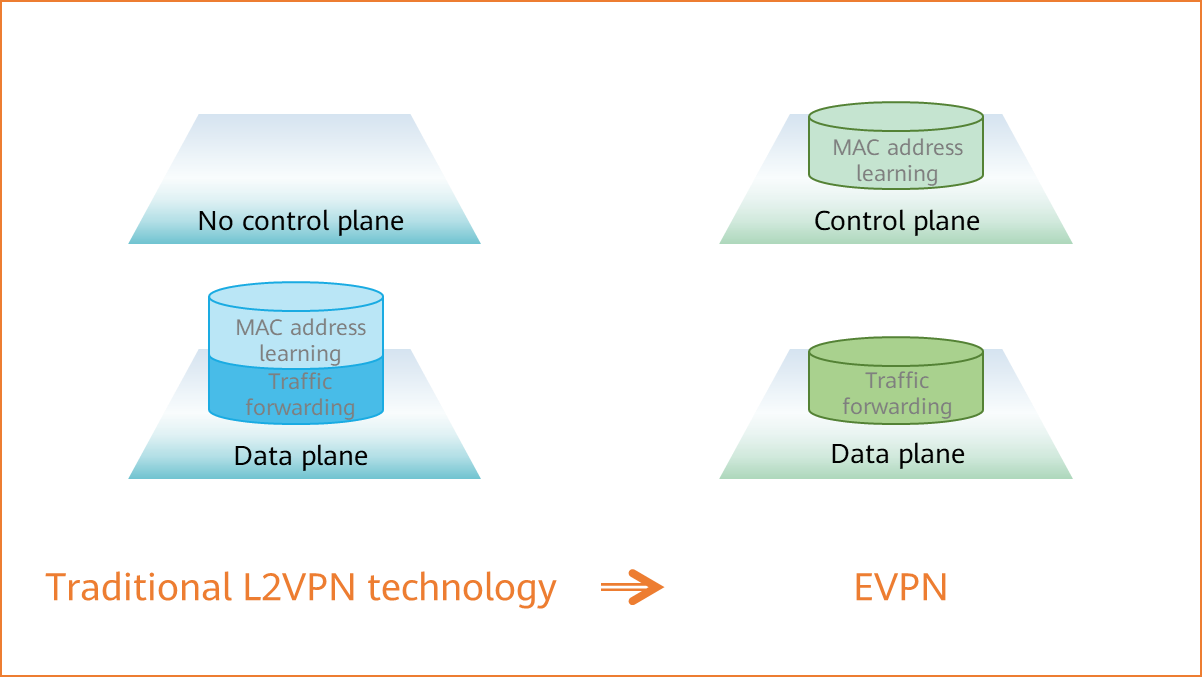
Comparison between EVPN and traditional L2VPN
EVPN introduces the advantages of IP VPN traffic balancing and flexible deployment to Ethernet, solving traditional L2VPN's problems such as high network resource consumption and the inability to implement load balancing. In addition, EVPN can carry L3VPN services, reducing protocol complexity.
SR-MPLS or SRv6 is used for tunnels on a 5G transport network, and EVPN is used for VPNs, simplifying protocols in the overall transport solution.
FlexE
Flexible Ethernet (FlexE) is an interface technology that implements service isolation and network slicing on a transport network. Based on the standard Ethernet technology defined in IEEE 802.3, FlexE decouples the MAC layer from the PHY layer by adding a FlexE shim layer between them. With FlexE, the one-to-one mapping between MACs and PHYs is no longer necessary, and M MACs can be mapped to N PHYs, thereby implementing flexible rate matching.
For example, one 100GE PHY can be divided into a pool of twenty 5 Gbit/s timeslots, and service interfaces can flexibly apply for separate bandwidth from this pool.
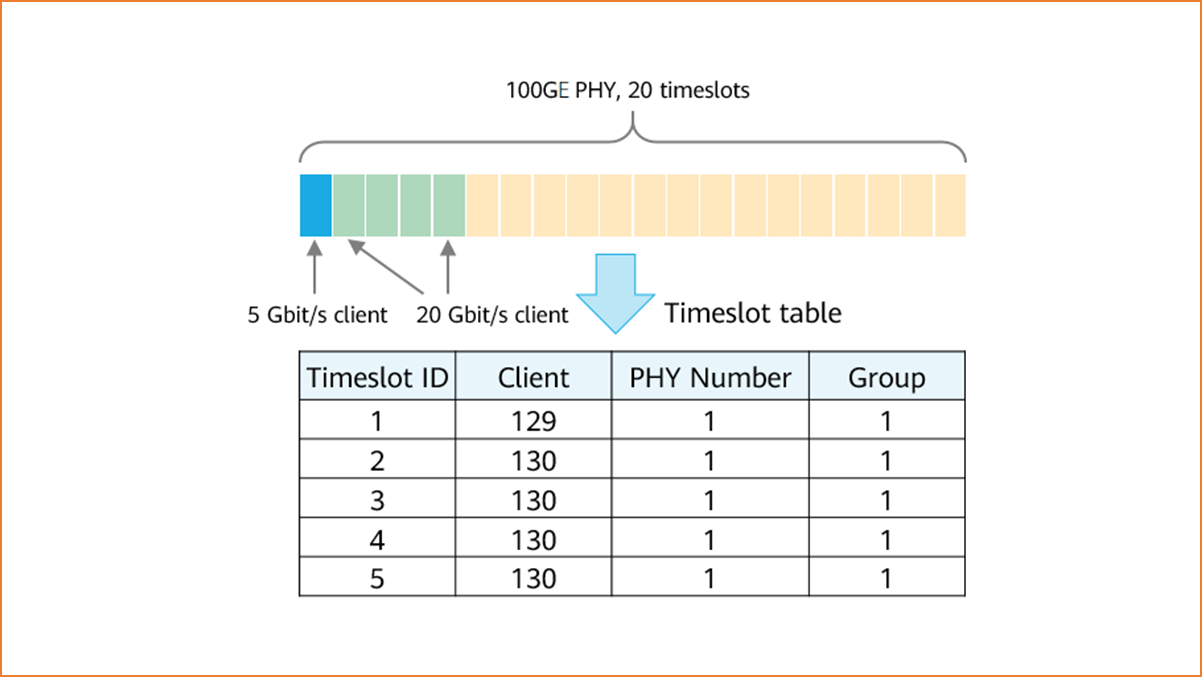
FlexE timeslot table
In addition, FlexE supports enhanced QoS for multi-service bearing. Specifically, FlexE provides channelized hardware isolation on physical-layer interfaces to implement hard slicing for SLA assurance and isolated bandwidth for services.
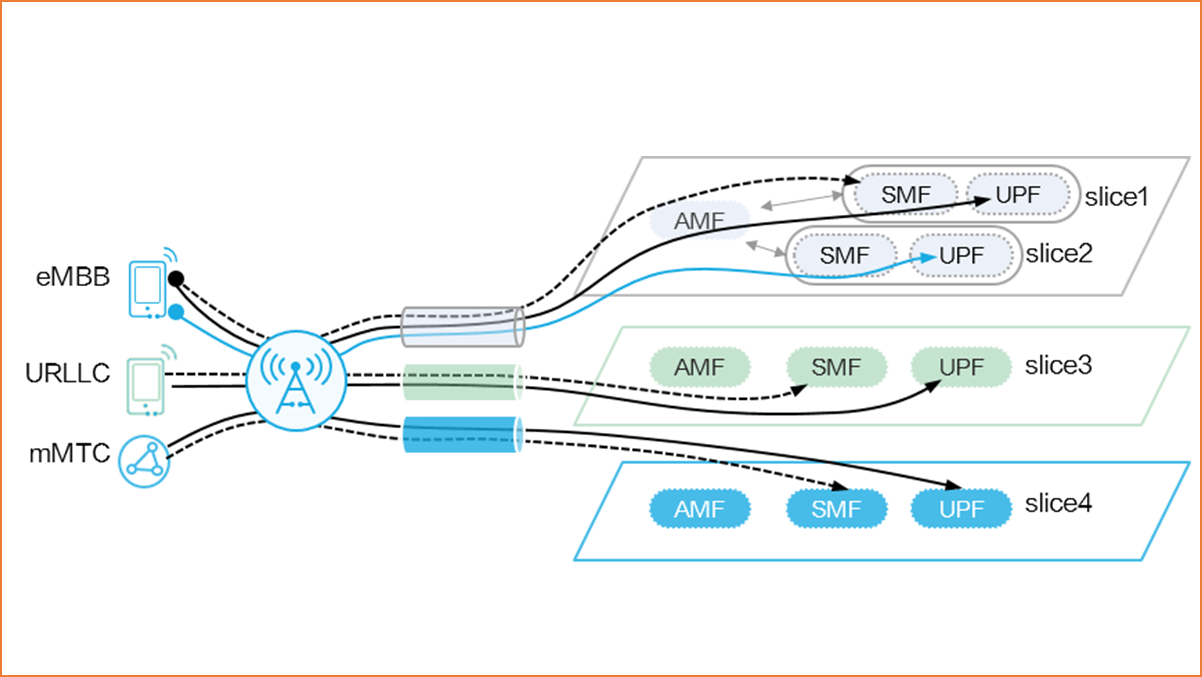
In the figure, the access and mobility management functions (AMFs), user plane functions (UPFs), and session management functions (SMFs) are functional units in the core network.
5G network slicing
IFIT
In-situ Flow Information Telemetry (IFIT) is a measurement technology that marks the characteristics of real service flows on a network to directly measure performance indicators, such as the latency, packet loss rate, and jitter.
5G transport networks are facing new requirements and challenges, such as ultra-high bandwidth, massive connections, high reliability, and low latency. IFIT adds an IFIT packet header to real service packets to measure performance and reports measurement data in real time through telemetry. Per-packet or per-flow performance indicators are then displayed on the GUI of iMaster NCE-IP. IFIT can significantly improve the timeliness and effectiveness of network O&M and performance monitoring, enables SLAs to be guaranteed, and lays a solid foundation for intelligent O&M.
- Extensibility: IFIT features high measurement precision and easy deployment and can be easily extended in the future.
- Fast fault locating: IFIT provides in-band flow measurement to help measure the latency and packet loss of service flows in real time.
- Visualization: IFIT allows performance data to be displayed on the GUI so that users can quickly find failure points.

IFIT measurement based on real service flows
- Author: Wu Zhuoran
- Updated on: 2023-04-08
- Views: 18716
- Average rating:







